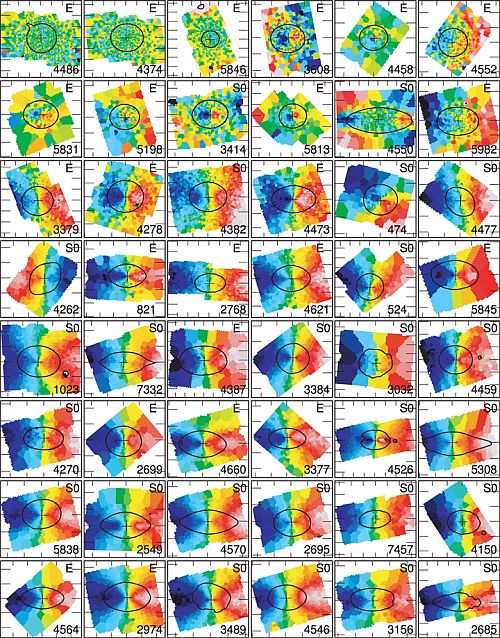 | |||
|
| Home > Public Information > Scientific Highlights > 2007 > The SAURON Project |
The SAURON Project | ||
|
WHT+SAURON
SAURON (Spectroscopic Areal Unit for Research on Optical Nebulae) is a panoramic integral-field spectrograph built for the WHT by groups in Leiden, Lyon and Oxford. SAURON can record 1577 spectra simultaneously, with full sky coverage in a field of 33' by 44' and it was used to
measure the kinematics and line strength distribution for a representative sample of 72 nearby early-type galaxies (ellipticals, lenticulars, and Sa bulges, in clusters and in the field).
In parallel with the data taking, the team developed a number of tools that are key to analyze all the resulting maps, and in particular they built an elaborate software pipeline to reduce and analyze the data which produce full 2D maps of velocity from both stellar absorption lines and ionized gas emission lines, of velocity dispersion and of line ratios. SAURON saw first light at the WHT in 1999. The entire survey was completed in 2003, and the instrument continued operational in the following years. Up to 2007, the SAURON collaboration had published more than 10 research papers covering differents aspects of the research. Which follows is a summary of the papers published in 2006 and 2007. A study dealing with the fundamental plane of early-type galaxies, showed that the scatter in the mass-to-light ratio vs. galaxy mass relation was extremely small, and that small ellipticals in their central regions have almost no dark matter. A second paper showed that early-type galaxies contain large amounts of ionized gas, in many cases in regular, stable orbits, but also in other cases showing signs of infall. A third paper provided 2D absorption line strength indices for the elliptical and S0 galaxies in the survey, and another work provides velocity and velocity dispersion fields for gas and stars in the 24 early-type spirals of the SAURON survey. A major result is that many of these objects have central disks dominating the light there. The kinematics of gas and stars and absorption line strength maps for a large fraction of these galaxies, and a number of newly discovered kinematically decoupled cores, were presented in a different paper. Two-dimensional stellar kinematics of 48 representative elliptical and lenticular galaxies revealed that early-type galaxies appear in two broad flavours, depending on whether they exhibit clear large-scale rotation or not.
An analysis of the orbital distribution of elliptical and lenticular galaxies kinematics within about one effective (half-light) radius showed that two classes: the slow rotators are more common among the most massive systems and are generally classified as ellipticals from photometry alone. Those in the analysed sample tend to be fairly round, but can have significant kinematical misalignments, indicating that as a class they are moderately triaxial; the fast rotators are generally fainter and are classified as either elliptical or lenticular. They can appear quite flattened, do not show significant kinematical misalignments (unless barred or interacting), indicating they are nearly axisymmetric and span an even larger range of anisotropies. A number of the fast rotators show evidence for containing a flattened, kinematically distinct component, which in some cases counter-rotates relative to the main galaxy body. These components are generally more metal rich than the galaxy body. All these results support the idea that fast rotators are nearly oblate and contain disc-like components. The role of gas must have been important for their formation. The slow rotators are weakly triaxial. Current collisionless merger models seem unable to explain their detailed observed properties. The absorption-line strength maps of a sample of 24 representative early-type spiral galaxies, mostly of type Sa, showed that the central regions of Sa galaxies contain at least two components: a thin, disc-like component, often containing recent star formation, and another, elliptical-like component, consisting of old stars and rotating more slowly, dominating the light above the plane. These components together form the photometrically defined bulge, in the same way as the thin and the thick disc co-exist in the solar neighbourhood. In this picture, part of the bulge, the thicker component, formed a very long time ago. Later, stars continued to form in the central regions of the disc, rejuvenating in this way the bulge through dynamical processes. This picture is able to explain in a natural way the heterogeneous stellar populations and star formation characteristics that we are seeing in detailed observations of early-type spiral galaxies. References:
|
| Top | Back |
|


